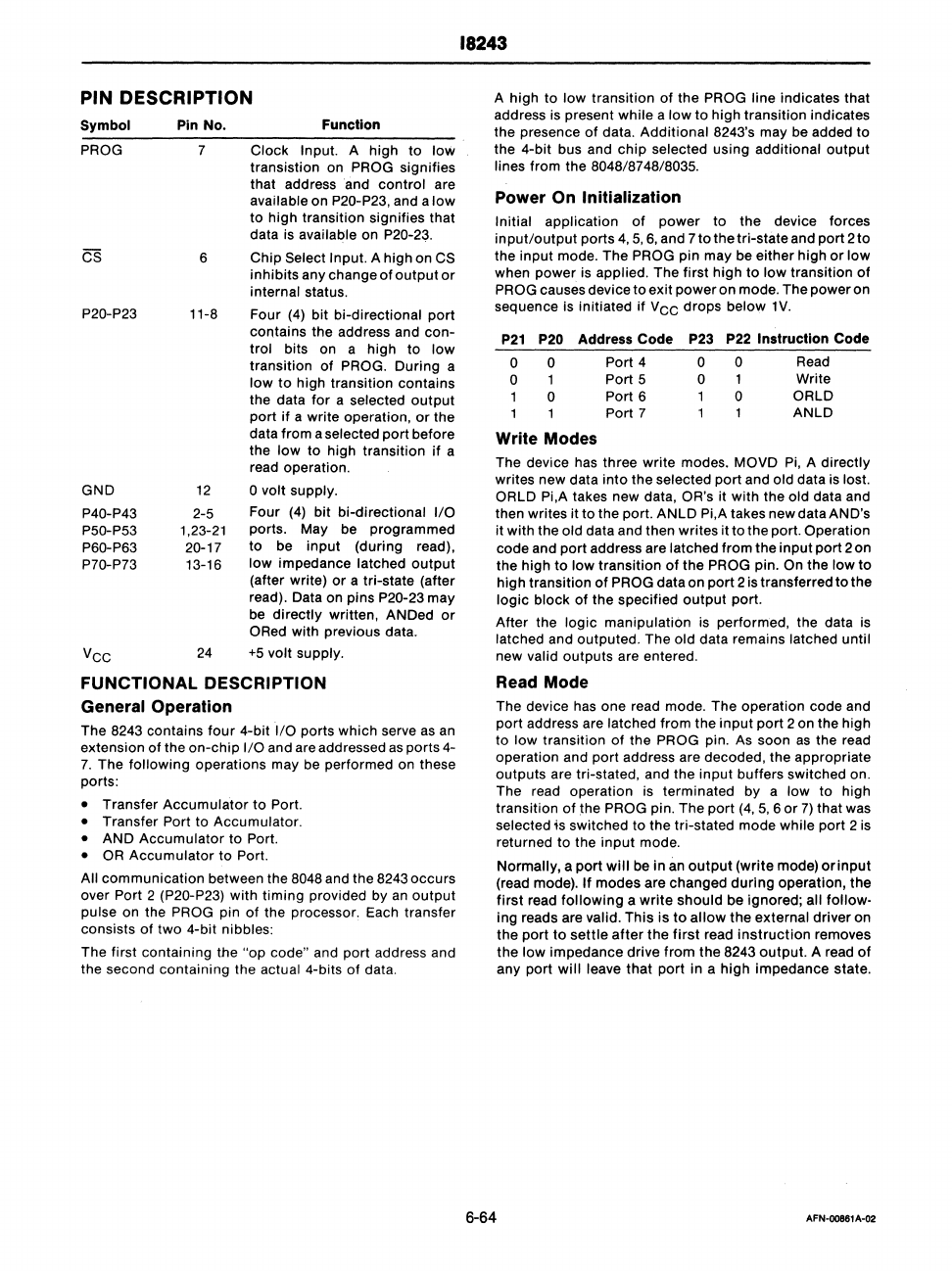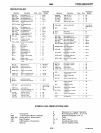
PIN DESCRIPTION
Symbol
PROG
P20-P23
GND
P40-P43
P50-P53
P60-P63
P70-P73
Vee
Pin No. Function
7 Clock Input. A high
to
low
transistion on PROG signifies
that address
and
control are
available on P20-P23, and a
low
to high transition signifies that
data is
available on P20-23.
6 Chip
Select Input. A high on CS
inhibits any change
of
output
or
internal status.
11-8 Four
(4)
bit bi-directional
port
contains the address and
con-
trol bits on a high
to
low
transition of PROG. During a
low
to
high transition contains
the data
for
a selected
output
port if a write operation,
or
the
data from a
selected port before
the
low
to
high transition if a
read operation.
12
2-5
1,23-21
20-17
13-16
o volt supply.
Four
(4)
bit bi-directional
I/O
ports. May be programmed
to
be
input
(during read),
low
impedance latched
output
(after write) or a tri-state (after
read). Data on pins P20-23 may
be
directly written, ANDed
or
ORed with previous data.
24
+5
volt supply.
FUNCTIONAL DESCRIPTION
General
Operation
The 8243 contains
four
4-bit
I/O
ports which serve
as
an
extension
of
the
on-chip
I/O
and are addressed
as
ports 4-
7.
The
following
operations may be performed on these
ports;
• Transfer
Accumulator
to
Port.
• Transfer Port to Accumulator.
•
AND
Accumulator
to
Port.
•
OR
Accumulator
to
Port.
All communication between the 8048 and the 8243
occurs
over Port 2 (P20-P23) with timing provided by
an
output
pulse on the PROG pin
of
the processor. Each transfer
consists
of
two
4-bit nibbles;
The first containing the
"op
code" and port address and
the second containing the
actual 4-bits
of
data.
18243
A high
to
low transition of the PROG line indicates that
address is present
while a low
to
high transition indicates
the presence
of
data. Additional 8243's may be added
to
the 4-bit bus and chip selected using additional
output
lines from the 8048/8748/8035.
Power
On
Initialization
Initial application
of
power
to
the
device forces
input/output
ports
4,
5,
6,
and 7
to
thetri-state
and port
2to
the input mode. The PROG pin may be either high
or
low
when power
is
applied. The first high
to
low transition
of
PROG causes device
to
exit
power
on mode. The power on
sequence is initiated if
Vee
drops below
1V.
P21
P20 Address Code P23
P22
Instruction Code
0
0
Port 4
0
0
Read
0
1
Port 5 0 1
Write
0
Port 6 0
ORlD
Port 7
ANlD
Write Modes
The device has three write modes.
MOVD
Pi,
A directly
writes new data
into
the selected
port
and old data is lost.
ORlD
Pi,A takes new data, OR's it with the old data and
then writes it
to
the port.
ANlD
PiA
takes new data AND's
it with the
old data and then writes it
to
the port. Operation
code and
port
address are latched from
the
input
port 2
on
the high
to
low transition
of
the
PROG pin. On
the
low
to
high transition
of
PROG data on
port
2 is transferred
to
the
logic
block
of
the
specified
output
port.
After the
logic manipulation
is
performed, the data is
latched and outputed. The old data remains latched until
new valid outputs are entered.
Read Mode
The device has one read mode. The operation code and
port
address are latched from the
input
port
2 on the high
to
low transition of the PROG pin.
As
soon
as
the read
operation and port address are decoded, the appropriate
outputs are tri-stated, and the
input
buffers switched on.
The read operation
is
terminated by a low
to
high
transition
of
the PROG pin. The
port
(4,
5,
6 or
7)
that was
selected
is
switched to the tri-stated mode while port 2 is
returned
to
the
input
mode.
6-64
Normally, a port
will
be in
an
output
(write
mode)
orinput
(read mode).
If
modes are changed
during
operation, the
first
read
following
a
write
should
be ignored; all follow-
ing reads are valid.
This
is
to
allow
the
external driver on
the
port
to
settle
after
the
first
read
instruction
removes
the
low impedance drive
from
the
8243
output.
A read
of
any port
will
leave
that
port in a high impedance state.
AFN-00861A-02


















